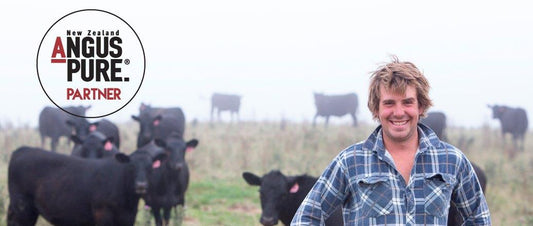The philosophy at King Country Angus stud Storth Oaks is straightforward: Tim and Kelly Brittain’s goal is to improve the profitability of their customers.
“We believe we can achieve that through using the best technologies available.”
Kelly and Tim are leaders in the new wave of farming that combines a passion for agriculture with an innovative and forward-looking approach that doesn’t shy from leveraging every advantage.
“It’s not enough to do things the way they’ve always been done,” says Tim. “We need only look to other meat industries to see that there is real opportunity for beef to improve – but it involves grasping the technologies now available and setting our goals high.”
Storth Oaks is a North Island hill country property on free-draining Mairoa Ash soil with an elevation up to 315m and annual rainfall of 1650mm. When the family purchased the original 218ha farm, back in the days of Queen St Farmers and livestock incentive schemes, it was three-quarters covered in scrub. Six years into a development programme, Tim purchased a more established and easier-contoured neighbouring property, and the two farms were run jointly for a decade. From 1995, when Tim and his brother Chris divided the family property operations between them, Tim and Kelly have run Storth Oaks in their own right, whilst also retaining Auckland business interests with Brittain Wynyard & Co Ltd.
“When we began the money was in bull beef,” Tim recalls, “but they weren’t good at tidying up the regrowth in the development area, so we decided to get some cows.”
In 1991 Tim bought 37 in-calf stud cows at a local Angus dispersal sale, prompting long-time Angus breeder Dick Jolly to nominate him as a member of NZ Angus.
Tim found himself ‘captured’. “Things went full steam ahead. I was immediately interested in recording weights and growth rates; testing whether there was an effect from using selenium, cobolt, etc.”
The approach was tailor-made to sit well with Tim’s business background and enthusiasm for computers. “I had started down the path of farm computing in the mid 1980s, doing primitive feed budgets and all sorts of on-farm recording. When not only financial programmes but studstock recording packs came out, I thought ‘wow!’ Right from the start, we began using Herd Magic.”
By the mid 1990s, the couple’s focus was clearly defined. Initially they sold a few bulls at the Te Kuiti Bull Sale then, in 2002, launched an on-farm sale.
From the outset the Brittains have been early adoptors of technology – ‘at the bleeding edge’, Tim quips – mating yearlings, investing in genetic technologies, aiming for improved growth rates and carcass merit, long before carcass EBVs.
“In order to get the fastest gain, we used AI right from the start. We bought another 20 stud cows, a few at every dispersal that came up, and ten Te Mania heifers that had come up to the North Island be flushed for Te Mania Australia.”
The policy saw them build numbers quickly. “We did a lot of ET work, reflushing the Te Mania heifers and a couple of cows from Totara Hills dispersal, growing the numbers very fast.”
Tim had always been interested in recording, and it was seeing the progress, seeing the results coming through, that drove him initially.
“These days it’s about being able to develop returning customers and seeing their satisfaction with our bulls. It’s the belief, right or wrong, that our programme is going in a direction that is assisting the industry in meeting customer satisfaction. We want to ensure our commercial customers are profitable so they can continue to run commercial beef cows.”
And that means taking advantage of every opportunity to maximise profit for farmers. “To do that we have to maximise all the efficiency gains: feed efficiency, growth carcass attributes – all the attributes that ensure customer satisfaction with eating quality.”
New Zealand lags behind other countries on technology uptake, Tim says.
“It’s clear from the research that Generation X consumers are prepared to pay more for quality, and are loyal to brands when the product is good. In the USA there is a widening gap between what people are prepared to pay for prime and for lower quality. Farmers have to make a choice about whether they are in the prime industry or in lower cuts production. If it’s the latter, go for dairy beef. If you’re in prime, marbling is the number one indicator of quality eating experience. Why wouldn’t you build that into your breeding programme?”
The Brittains calve between 300 and 315 cows, including 70-80 R2 heifers. “We’re aiming to shorten the turnover of cows, to shorten the generation interval and make quicker genetic progress. And with the beef schedule high you can get out of older cows quite profitably.”
They sell 60-65 R2 bulls at their sale, which sees a strong presence from Otorohanga, Taumarunui, Taihape, Coromandel, Gisborne – with few breeding cow herds left in the northern King Country, they rely on bringing people from all over the North Island.
“You don’t want to breed by fashion but by programme,” Tim says. “People can go too far if they go for the latest trend. But if you have a breeding objective to improve efficiencies and carcass attributes, you’ll keep moving forward. You might still make mistakes; buy the wrong bull then a few years on realise it’s been a mistake. In that situation you just have to be ruthless. Quit them or use them as embryo carriers.”
The Storth Oaks breeding programme is very much AI dominated: three cycles of fixed-time AI on MA cows and two cycles on yearling heifers, with yearling bulls as a third cycle follow-up on heifers.
“It gives us the best and biggest genetic pool. We can use a dozen or more bulls instead of one or two,” Kelly says.
They tend to favour Australian genetics; often the sons of US bulls. “It means we can test out those genetics in Australia, plus it gets them into BREEDPLAN, which is more predictable for us; there are always surprises when EPDs are converted to EBVs. It also makes it feasible to go and look at the dams and herds they’re coming from.”
To assist with mating selections they use TGRM (Total Genetics Resource Management) – a computer model that looks at each animal’s genetic make-up and aims to maximise gains based on your stated objectives; put a lot of emphasis on the AP index – “We don’t follow it slavishly; it’s a tool in the box,” Kelly says; and use an Australian geneticist who works with a lot of Australian herds.
“Pig, dairy and chicken breeders take a similar approach, with demonstrably outstanding results,” Tim adds. “Why wouldn’t beef farmers do the same?”
INTENSIVE PROGRAMME FOR TOP RESULTS
Storth Oaks aims to have product to finish through the winter, when demand is strongest. To ensure they can meet the brief, they look for feedback from their processor.
“We target the programme that provides an instant read on where our cattle sit at that time of year, in those conditions and feeding regimes.” The new SFF grading system is an attraction, Tim says, allowing them to gauge how their cull heifers and steers are going, and to assess whether they’re making progress on their specific goals. “We’re also working with AngusPure and Wilson Hellaby to provide the same grading and feedback.”
Based on anecdotal evidence that South Island Angus farmers were getting good results from fodder beet, the Brittains trialled the crop last year, using it not for finishing cattle but for wintering bulls. Though land for cropping is limited, with increasing summer dries over the last decade, they’ve also increased their acreage of kale and rape.
“The farm is run incredibly intensively,” Tim says. “We run a very high stocking rate which forces us to use break feeding, crops and supplementary feeding. All heifers run in one contemporary group; bulls the same – typically 140 yearlings in each mob. That way they have to compete, and it improves the accuracy of the 400 Day weight observations and measurements.
“We really test the cows on the hills; they’re run under commercial conditions. It’s genuine hill country, and young country.”
Before being put up for sale, bulls are rigorously tested. Kelly is a qualified Beef Class assessor but they use an independent assessor, Simmental and Angus breeder John Hammond, to class all cattle going up for sale.
“The aim is to ensure the customer is getting what they expect: a top class, high performing bull,” Kelly says.
They semen test rather than Blocky test. “We measure that they can mount, but it’s not about frequency – we check semen quality and morphology; check the penis. Scanning is standard, undertaken by Bill and Judy Austin. For the last four years we have DNA sire verified all calves so that we can give assurance to customers.”
Starting with DNA sire verification, Storth Oaks uses HD50K DNA sequencing to help select the yearling bulls they will use across the heifers in the third cycle. They are currently using the new i50K, which Tim describes as more affordable. “It measures a fraction fewer markers but the software can extrapolate at 99% accuracy across the traits and from the 2015 calf drop on every calf born at Storth Oaks and DNA sequenced using i50K.”
Alongside his involvement in the wider agricultural industry, Tim has been a key figure in the development of AngusPure, of which he is chairman.
“AngusPure is the official brand of Angus NZ, and has been a catalyst in helping change the way we market and buy beef. Consumers now buy a brand. There have been quite a few ‘me too’s who have come along on the coat-tails, and that’s positive. Providing we can work with our processing partners to improve the consistency and quality through good grading systems, and reward the farmers who are producing the marbled product, AngusPure can continue to provide the major reason for New Zealand farmers to be buying Angus bulls.”
The future for Angus is bright, Tim believes, “provided we take advantage of all the new technologies. We need to continue to push the boundaries. There’s a window of opportunity for Angus to accelerate, to hit it out of the ballpark. It’s up to each of us to take it.




